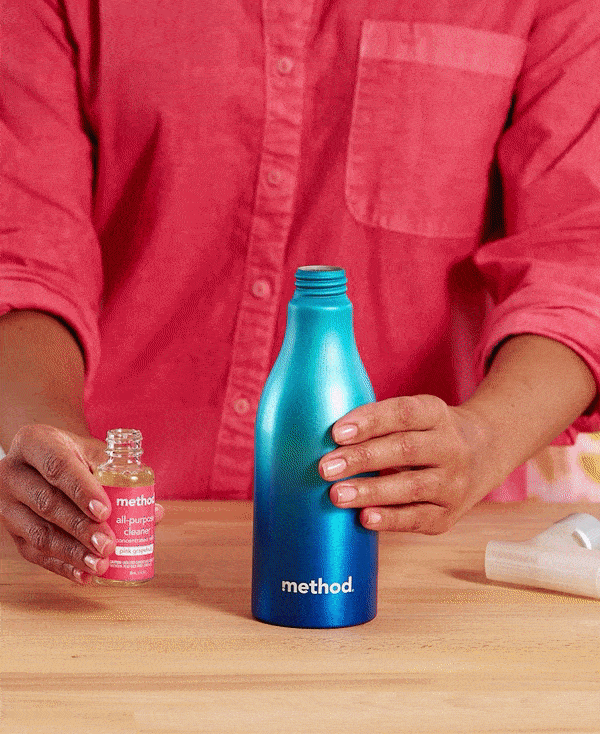Beyond the Bottle: Why Reduce and Reuse Come Before Recycle
As waves of single-use plastics continue to fill up landfills and pollute the environment, SC Johnson aims to drive product refill and reuse options to reduce plastic waste, decrease new plastic production and keep plastic already made in use.
Many people’s journey towards living a more sustainable lifestyle starts with their recycle bin. They wash and sort their plastic waste, mindful that contaminating the bin with unrecyclable materials could risk diverting the entire lot to the landfill. As we become more diligent about purchasing products that are more easily recyclable or made from recyclable materials, that bin can fill up fast. And that’s a good thing, right?
Yes, but it depends on what is in your recycling bin. There’s a reason that “Reduce” and “Reuse” come before “Recycle” in that catchy slogan. Inevitably, that reason comes down to single-use plastics.
Single-use plastic, or disposable plastic, is any item used once and thrown in the trash. Single-use plastics are primarily used for packaging and service ware, such as bottles, wrappers, straws and bags. Worldwide, half of the 300 million tons of plastic produced yearly is for single-use items. That’s nearly equivalent to the weight of the entire human population.
Data like that gives businesses, governments and consumers direction on what actions are meaningful to tackle the plastic waste crisis. In its 2022 Global Commitment progress report, the Ellen MacArthur Foundation and the UN Environment Programme noted that brands and retailers “must adopt ambitious strategies to scale up reuse schemes, innovate away from flexible plastic packaging where possible, and reduce their use of single-use packaging.”
That sentiment was also echoed recently in an address to the annual Retail Council of Canada’s Retail Sustainability Conference by SC Johnson’s Chairman and CEO Dr. Fisk Johnson, where he said, “The environmental benefit of refilling and reusing containers in both carbon and plastic reduction is unparalleled” and that “it is incumbent on all of us, manufacturers and retailers alike, to work hard to continue to innovate refill/reuse options that are as convenient and cost-effective as possible.”

So, when you look in that overflowing recycling bin, how much is genuinely single-use plastic versus plastic that can be reused or refilled?
Breaking the Single-Use Culture
To say single-use plastics have an enormous impact on our daily lives is a massive understatement. It is nearly unavoidable, no matter how hard you try. The straw with your iced coffee. The clamshell container your online food order was delivered in. The wrapper on a candy bar you bought for your afternoon snack. They are destined for the landfill after one use, at best, because they are designed for single use and, in most cases, the infrastructure doesn’t exist to collect and process those types of plastics. The only option is to reduce their use.
However, other plastic products and containers have a second option before they re-enter the recycling stream: reuse and refill.
Plastic Bottles and Triggers are Only Single-Use if You Use Them Once
Of course, embracing refills and reusing spray triggers doesn’t mean you have to use a plastic bottle. In select retail stores, Mrs. Meyer’s® Clean Day foaming hand soap concentrate starter kit comes with a reusable glass bottle and two ready-to-use refills, and each concentrate uses 99% less plastic than the equivalent single-use plastic bottle. Similarly, method® foaming hand wash and all-purpose cleaners are also available in aluminum bottle dispensers that save over 96% plastic every time it’s refilled compared with the equivalent single-use plastic bottle.

Technology also continues to advance in ways that reduce the need to buy a bottle with refill concentrate. In 2022, SC Johnson introduced Dissolve™ Concentrated Pods for its Windex® Glass Cleaner, Windex® Multisurface Cleaner, Scrubbing Bubbles® Bathroom Cleaner and fantastik® Kitchen Cleaner. They dissolve in water from the tap, meaning all you have to do is pop one into an empty spray bottle, fill it up, shake it and start cleaning. Not buying new plastic spray triggers or liquid concentrate bottles means less container waste.
Every Meaningful Action Matters
To be clear, just like recycling, adopting a refill and reuse mindset alone will not solve the plastic waste crisis we are currently facing. Businesses and manufacturers need to continue cutting down on plastic use in their products and packaging, and governments need to enact legislation where producers bear some responsibility for the cost and governance of the collection and recycling infrastructure. During his address to the Retail Council Conference, Dr. Johnson reinforced that point of view, saying, “If we are going to make real progress, we need governments around the world to pass strong practical plastic regulation.” Later, he gave another straightforward assessment: “I personally believe – maybe a bit controversially – if we are to get significant scale in refill and reuse innovations, we are going to need more of a regulatory push.”
However, even though the systemic change needed to drive transformative change isn’t there yet, refills and reuse – along with recycling – are meaningful, everyday things you can do to help break the single-use plastic culture. Giving plastic a second, third, or fourth life not only helps reduce the demand for virgin plastic and the emissions-intensive production processes required to make it, but it can also spare the environment hundreds of plastic bottles each year. According to a report by the World Economic Forum, if just 10 to 20 percent of the plastic packaging produced today were reused, it could cut the amount of plastic waste entering the ocean in half.
So yes, bonus points for filling up your recycling bin. However, before you toss it in, it is worth wondering if you can still get more use out of that bottle. After all, it’s only single-use plastic if you use it once.